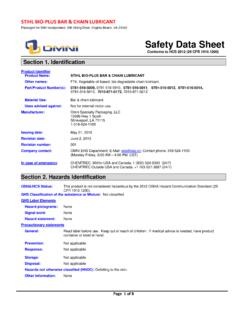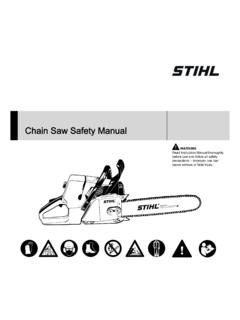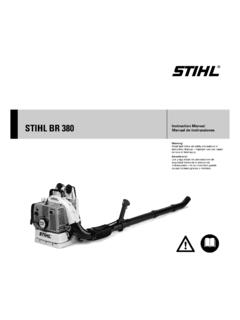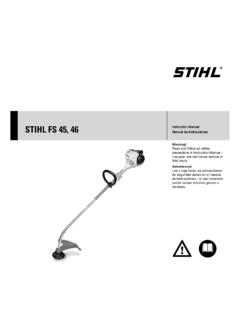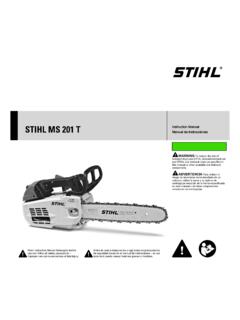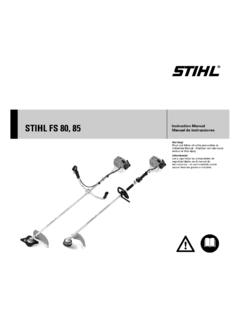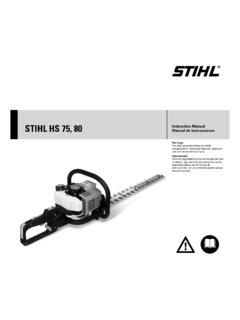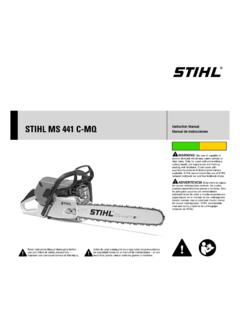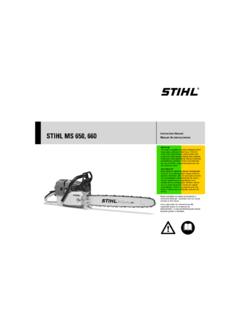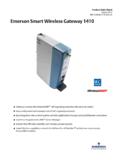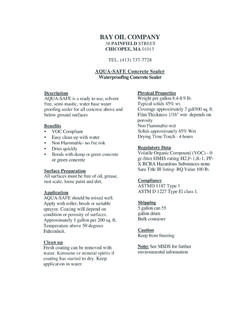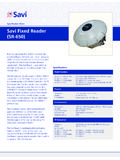Transcription of Safety Data Sheet - STIHL
1 STIHL MOTOMIX . Packaged for STIHL Incorporated, 536 Viking Drive, Virginia Beach, VA 23452. Safety data Sheet Conforms to HCS 2012 (29 CFR ). Section 1. Identification Product identifier Product Name: STIHL MOTOMIX High Performance Patented Fuel Part/Product Number(s): 7010-871-0203, 7010-871-0204, 7010-871-0234, 7010-871-0235, 7010-871-0248. 7010-871-0249, 7010-319-0003, 7010-319-0004, 7010-871-0273. Material Use: Premixed 2-cycle engine fuel mixture Uses advised against: Not for use in non-2-cycle engines Manufacturer: Omni Specialty Packaging, LLC. 10399 Hwy 1 South Shreveport, LA 71115. 1-318-524-1100. Issuing date: June 3, 2015. Revision date: November 29, 2016. Revision number: 005.
2 Company contact: OMNI EHS Department: E-Mail: Contact phone: 318-524-1100. (Monday-Friday, 8:00 AM 4:00 PM, CST). In case of emergency: CHEMTREC: Within USA and Canada: 1 (800) 424-9300 (24/7). CHEMTREC: Outside USA and Canada: +1 703-527-3887 (24/7). Section 2. Hazards Identification OSHA/HCS Status: This product is considered hazardous by the 2012 OSHA Hazard Communication Standard (29 CFR. ). US GHS Classification of the Substance or Mixture: Flammable Liquid Category 1. Aspiration Hazard Category 1. Skin Corrosion/Irritation Category 2. Specific Target Organ Toxicity (Single Exposure) Category 3 (respirator irritation, narcosis). Hazardous to the Aquatic Environment Chronic Category 2.
3 GHS Label Elements Hazard pictograms: Signal word: DANGER. Hazard statement: Extremely flammable liquid and vapor. Causes skin irritation. May cause drowsiness or dizziness. May be fatal if swallowed and enters airways. Toxic to aquatic life with long lasting effects. Page 1 of 9. STIHL MOTOMIX November 29, 2016. Precautionary statements General: Read label before use. Keep out of reach of children. If medical advice is needed, have product container or label at hand. Prevention: Keep away from heat/sparks/open flames/hot surfaces. No smoking. Keep container tightly closed. Ground and bond container and receiving equipment. Use explosion-proof electrical/ventilating/lighting/equipmen t.
4 Use only non-sparking tools. Take precautionary measures against static discharge. Use personal protective equipment as required. Wear protective gloves/protective clothing/eye protection/face protection. Wash hands and forearms thoroughly after handling. Do not breathe mist/vapors/ sprays. Use only outdoors or in well-ventilated area. Do not eat, drink or smoke when using this product. Avoid release to the environment. Response: Collect spillage. In case of fire: Use water spray, fog, dry chemical fire extinguishers or hand held fire extinguisher. IF ON SKIN (or hair): Wash with plenty of soap and water. Remove/Take off immediately all contaminated clothing and wash before reuse.
5 If skin irritation occurs, get medical advice/attention. IF INHALED: Remove victim to fresh air and keep at rest in a position comfortable for breathing. Call a poison center or doctor/physician if you feel unwell. IF SWALLOWED: Immediately call a POISON CENTER or doctor/physician. Do not induce vomiting. Storage: Store in a well-ventilated place. Keep cool. Keep container tightly closed. Store locked up. Disposal: Dispose of contents/container in accordance with local/regional/national/international regulations. Hazards not otherwise classified (HNOC): Defatting to the skin. Section 3. Composition/Information on Ingredients Mixture consisting of the following components, special 2-stroke gasoline.
6 Substance/Mixture: Mixture Components Name CAS number Weight %* GHS Classification Naphtha (petroleum), full-range alkylated, 68527-27-5 50 100 Flam. Liq. 1, Asp. Tox. 1, Skin Irrit. butane-contg. STOT-SE 3, Aquatic Acute 2, Aquatic Chronic 2. Methylbutane (Isopentane) 78-78-4 10 25 Flam. Liq. 1, Asp. Tox. 1, STOT-SE 3, Aquatic Chronic 2. Hydrocarbons, C4, 1,3-Butadiene-free, 93685-81-5 10 25 Flam. Liq. 1, Asp. Tox. 1, polymd., triisobuylene fraction, Aquatic Chronic 4. hydrogenated 2-Cycle Engine Oil Additives Mixture Proprietary <1 Not classified * The exact percentage of composition has been withheld as a trade secret. Section 4. First Aid Measures Description of necessary first aid measures Eye contact: In case of contact, immediately flush eyes with plenty of water for at least 15 minutes.
7 Eyelids should be held away from the eyeball to ensure thorough rinsing. Check for and remove any contact lenses. Get medical attention. Skin contact: Wash off immediately with soap and plenty of water while removing all contaminated clothes and shoes. Get medical attention if irritation or redness develops. Page 2 of 9. STIHL MOTOMIX November 29, 2016. Inhalation: If inhaled, remove to fresh air. If person is not breathing, provide artificial respiration. If necessary, provide additional oxygen once breathing is restored if trained to do so. Get medical attention immediately. Ingestion: Do NOT induce vomiting. Do not give liquids. Obtain immediate medial attention. If spontaneous vomiting occurs, lean victim forward to reduce the risk of aspiration (inhalation into respiratory system).
8 Monitor for breathing difficulties. Small amounts of material which enter the mouth should be rinsed out until the taste is dissipated. Protection of first-aiders: No action shall be taken involving any personal risk or without suitable training. Remove all sources of ignition. Ensure that medical personnel are aware of the material(s) involved, take precautions to protect themselves and prevent spread of contamination. Wear personal protective clothing (see section 8). Most important symptoms and effects, both acute and delayed See Section 11 for more detailed information on health effects and symptoms. Most Important Symptoms and Effects: Aspiration hazard. If material enters lungs, signs and symptoms may include coughing, choking, wheezing, and/or fever.
9 The onset of respiratory symptoms may be delayed for several hours after exposure. Breathing of high vapor concentrations may cause central nervous system (CNS). depression resulting in dizziness, light-headedness, headache, nausea and loss of coordination. Continued inhalation may result in unconsciousness and death. Eye irritation signs and symptoms may include burning sensation and a temporary redness of the eye. Skin irritation signs and symptoms may include burning sensations, redness, swelling, and /or blisters. Note to physician: Treat symptomatically. Section 5. Fire-Fighting Measures Uniform Fire Code: Class IB. Flash Point: <-56 C ( F). Extinguishing Media Suitable Media: In case of fire, use extinguishing measures that are appropriate to local circumstances and the surrounding environment.
10 Use water fog, fire fighting foam (suitable for polar solvents), dry chemical, carbon dioxide (CO2) extinguisher or spray. Unsuitable Media: CAUTION: Use of water spray when fighting fire may be inefficient. Specific Hazards Arising from the Chemical: Keep product and empty container away from heat and sources of ignition as product will burn. Contact with strong oxidizers may cause fire. Vapors may be ignited rapidly when exposed to heat, spark, open flame or other source of ignitions. Flowing product may be ignited by self-generated static electricity. When mixed with air and exposed to ignition source, flammable vapors can burn in the open or explode in confined spaces.
